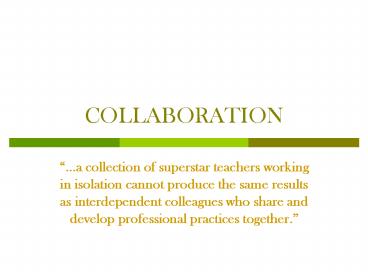COLLABORATION - PowerPoint PPT Presentation
1 / 15
Title: COLLABORATION
1
COLLABORATION
- a collection of superstar teachers working in
isolation cannot produce the same results as
interdependent colleagues who share and develop
professional practices together.
2
learning and change is intensely
interpersonal.(People getting smart together)
- Collaboration
- Sharing expertise and perspectives on teaching
and learning - Examining data about students
- Shared responsibility and mutual support for
effective instruction
3
Four Group-Member Capabilities
- To know ones intentions and choose congruent
behaviors. - To set aside unproductive patterns of listening,
responding, and inquiring. - To know when to self-assert and when to
integrate. - To know and support the groups purposes, topics,
processes, and development.
There is no such thing as group behavior. All
group behavior results from the decisions and
actions of individuals.
4
Unproductive patterns of listening, responding,
and inquiring
- Me Too Anecdotes and story telling
- Tell me moreHow much detail do we need on this
item? - I know what to doPressure toward action and away
from reflection
5
it is dangerous and often counterproductive
to put adults in a room without frameworks and
tools for skilled interaction.The Adaptive
School Garmston Wellman
- Teachers need instruction in building a
professional community to replace the isolation
that has been the norm for most teachers. - Ann Healy-Raymond, Professional Development
Specialist
6
The most important learning occurs through
relationships in community
- Seven Norms of Collaboration
- Tools for productive communication between group
members.
Norm Normal operating behaviors in formal and
informal interactions within the school.
7
Seven Norms of Collaboration
- 1. Pausing (wait time)
- after a question is asked
- after someone speaks
- after being asked a question- personal reflection
time a person waits before answering - collective pause
8
Seven Norms of Collaboration
- 2. Paraphrasing (a restatement of a text,
passage, or work giving the meaning in another
form) - Group becomes clearer and more cohesive about
their work. - Reflects content back to the speaker for further
consideration. - Connects the response to the flow of discourse
emerging within the group.
9
Seven Norms of Collaboration
- 3. Probing for Specificity
- Conversations go haywire when the various parties
make different assumptions about the meaning of
words and concepts and neglect to verify or
correct those assumptions.
10
Seven Norms of Collaboration
- 4. Putting Ideas on the Table
- Ideas are the heart of group work. To be
effective they must be released to the group. - Reconsidering ideas sometimes ideas need to be
pulled off the table.
11
Seven Norms of Collaboration
- 5. Paying Attention to Self and Others
- Skilled group members are aware of
- What they are saying
- How they are saying it
- How others are receiving responding to their
ideas. - The total communication package includes
- posture, gesture, proximity, muscle tension,
facial expression, and voice pitch, pace, volume,
and inflection
12
Seven Norms of Collaboration
- 6. Presuming Positive Intentions
- Encourages honest conversations about important
matters. - Reduces the possibility of the listener
perceiving threats or challenges in a paraphrase
or question.
13
Seven Norms of Collaboration
- 7. Pursue a balance between advocacy and inquiry.
- Spend equal amounts of time and energy advocating
for ones own ideas and inquiring into the ideas
of others. - Advocacy Make your thinking and reasoning
visible. - Inquiry Ask others to make their thinking visible
14
Any group that is too busy to reflect on its
work is too busy to improve.
- Two Important Things
- That we talk professionals who are charged with
preparing students to be successful collaborative
citizens are themselves cut off from the rich
resources offered by true collegiality. - How we talk it influences the personal and
collective satisfaction that motivates us to
effectively talk together in our schools.
15
Four Group-Member CapabilitiesandSeven Norms
of Collaboration
- These essential capacities and skills help
groups develop shared meaning and gracefully
reach decisions.

